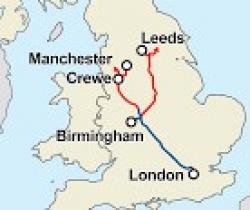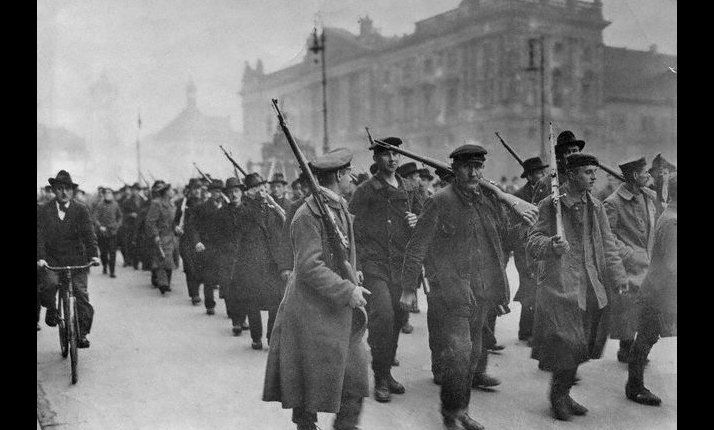By Andy Fenwick, Worcester South CLP personal capacity
Boris Johnson claims that he will invest in the ‘Red Wall’ constituencies is as much pie-in-the-sky as his other schemes. Remember the ‘island airport’ in the Thames estuary? Or the garden bridge over the Thames?
We have two more capital programs that will not come to completion at any time in the near future: a 22-mile bridge across the Irish sea to link Scotland to Northern Ireland, which would take 30 years to build and would require a new phase of logistics never done before to clear a million tons of high explosives dumped in the Irish sea after the end of the second world war. As one comic has said, it might be a costly leaving present for two newly-independent nation states. The second of these projects is the proposed High Speed 2 Train (HS2), to bring Birmingham 20 minutes closer to London, time which you would lose again by having to walk from Curzon Street, the HS2 terminus in Birmingham, to New Street Station, to continue your journey.
No direct link to Heathrow or the Channel
It’s not about ‘transport links’ at all. It’s about the Tory government wanting to spend money prop to up their friends in the construction firms like Balfour Beatty, Taylor Woodrow, Keir and Costain, to build the HS2 white elephant as well as Siemens, to supply the trains. Rather than spending money to overturn a decade of austerity, the government is spending billions on bailing out failing construction companies that depend on state contracts.
The majority of the capital expenditure on HS2 is to be spent in the south with more tunnelling under London and £2.5 billion alone being spent on a new station at Old Oak Common. Originally, the promise of HS2 was to either link directly with Heathrow Airport to be an alternative to a third runway, or be a direct connection to the Channel Tunnel, but now it has no direct connection to either.
Apart from the south east of England, this project will not boost productivity. What would be more useful would be to increase rail capacity across the majority of the country, with new faster rolling stock, platform extensions to take more coaches and electrification. We do not need any more routes that just focus only on London. Capacity is available but the privatisation of rail companies has put bottlenecks throughout the system. If Virgin scrapped the first class coaches and replaced them with standard class coaches, for example, it would increase capacity by 20% per train
London branch comes first
All that Johnson has promised is the first phase London to Birmingham to be complete by 2030 and the rest is up for a review, so it is quite possible that the second phase to Leeds and Manchester will be compromised by using current slower track and not specific high speed lines. Even then, it is at least another ten more years to wait. It is a pity that Labour mayors of northern cities are the flag-carriers for this mythic transport nirvana: both Andy Burnham Manchester Mayor and Steve Rotherham, Liverpool Mayor welcomed the promise of HS2, even though they’ll be old men by the time it is ever realised.
The cost of HS2 has risen massively, from £42.5 billion in 2009, to an estimated cost £106 billion now, only ten years later. So far £8 billion has been spent, without a single sod of earth been turned. All this money has flown into the bank accounts of architects, designers, consultants, company planners and the rest. Like the £50m of public money Boris Johnson threw away in the garden-bridge-that-never-was, when he was mayor of London. Except that HS2 is on a much more massive scale.
Private companies milk public contracts
HS2 Ltd has very variable approach to compensation for compulsory purchase orders. If your property is in the leafy countryside you can receive an inflated price and still live in the property. However if you happen to own a builder’s yard in Birmingham, which is needed for HS2 construction offices, you have to vacate immediately – but you do not receive the full compensation, and therefore you cannot move to an alternative site, laying off 20 workers. So much for levelling up.
If both phases of the project are ever completed, the track will cover 531km, stretching from London up to Birmingham, Manchester, Leeds and other cities. This means the total cost is equivalent to £104.8m per kilometre, far higher than any equivalent anywhere in the world. This is a direct result of the parasitic character of the private construction companies milking, as they do, any and every public contract. This cost can only be recovered from ticket prices, which will be prohibitive to ordinary workers. Moreover, planned capacity is not likely to be achieved, making the project a white elephant, as either prices will have to rise, adding to a vicious price spiral, or it will become another failed rail franchise and we will have to bail out the fat-cats who don’t even use the train.
A slalom through the countryside
The promise of genuine high speeds is challenged by the website of the HS2 Ltd itself. The straighter the track the faster the speed that can be achieved, but according to HS2, the track from London to Birmingham will slalom through the countryside, slowing down the potential speed. After Birmingham the HS2 train will use the current West Coast line and the northeast coast line sharing the track with slower trains. HS2 are committed to 400 metre long trains, with 20 carriages, 1280 seated passengers. Technically it makes sense, because a 400m-long tube has lower air resistance per seat than that two shorter trains. However, it is the sideways inertial forces, the force we all experience when a car takes a corner at speed, that will force the train to run slower, to avoid the contorted forces twisting a train of such length. The infrastructure required to provide the necessary stations will lead to beloved Victorian structures being knockdown to accommodate 500-metre platforms.
A socialist government would develop transport for all
Socialists are not opposed to developing public transport at all, if it were part of a publicly-owned and integrated transport network. After all, Britain has a great history of providing technical initiatives, from George Stephenson’s Locomotion No1 on the Darlington to Stockton railway in 1825, to British Rail’s 125 high speed train in the 1970s. It was Eric Laithwaite of Imperial College London, who developed the concept of the ‘maglev’ train as long ago as 1967, only to be ignored until the Japanese developed it for use on their Bullet Train. What is required is a socialist transport plan that answers the needs of all people in all parts of Britain, from Wick in Scotland to the Lizard in Cornwall. A socialist government could deploy all the latest developments in science for the betterment of the human race, including the extension of renewable energy to harness power for future generations to grow up in.
Rather than throwing money at the big private construction companies – which is the real aim of the HS2 project – Labour should develop a socialist alternative plan:
* Socialist Transport Transformation Plan
* Bring all Transport into public ownership: rail, road, air and shipping.
* Reopen the 6000 miles of branch lines closed in the 1960s by Beeching.
* Electrification of all railways, bus and coach services.
February 24, 2020



